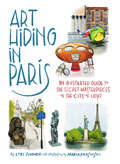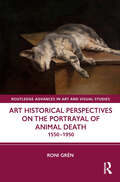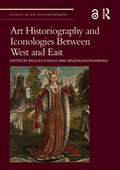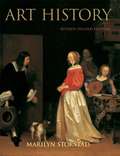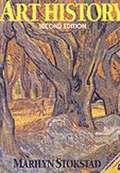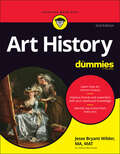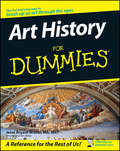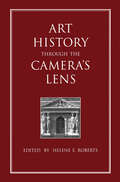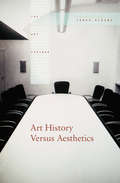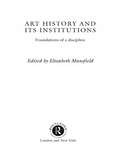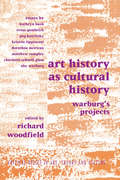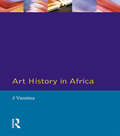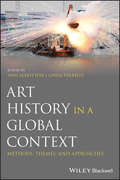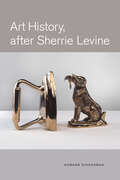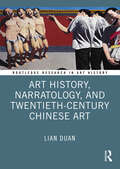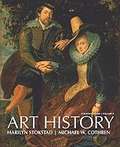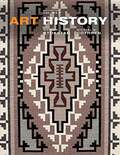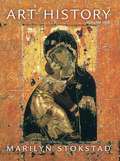- Table View
- List View
Art From the Ashes: A Holocaust Anthology
by Lawrence L. LangerArt from the Ashes provides the most far-reaching collection of art, drama, poetry, and prose about the Holocaust ever presented in a single volume. <p><p>Through the works of men and women, Jews and non-Jews, this anthology offers a vision of the human reality of the catastrophe. Essays by familiar writers like Primo Levi and Elie Wiesel accompany lesser-known efforts by Yankiel Wiernik and Frantisek Kraus; stories by Tadeusz Borowski and Ida Fink join fiction by neglected authors such as Isaiah Spiegel and Adolf Rudnicki; and extensive selections have been chosen from the works of six poets--the renowned Paul Celan, Nelly Sachs, and Abraham Sutzkever among them. <p><p>Each selection (except for self-contained excerpts from ghetto journals and diaries) appears here in its complete form. Langer also includes in their entirety a novel by Aharon Appelfeld, a novella by Pierre Gascar, and Joshua Sobol's controversial drama Ghetto. In addition, this volume features a visual essay in the form of reproductions of twenty works of art created in the Terezin concentration camp.
Art Hiding in New York: An Illustrated Guide to the City's Secret Masterpieces
by Lori ZimmerUncover the artistic masterworks hidden across New York City in this charmingly illustrated exploration of one of the world's greatest creative treasure troves.There's so much to love about New York, and so much to see. The city is full of art, and architecture, and history -- and not just in museums. Hidden in plain sight, in office building lobbies, on street corners, and tucked into Soho lofts, there's a treasure trove of art waiting to be discovered, and you don't need an art history degree to fall in love with it. Art Hiding in New York is a beautiful, giftable book that explores all of these locations, traversing Manhattan to brings 100 treasures to art lovers and intrepid New York adventurers. Curator and urban explorer Lori Zimmer brings readers along to sites covering the biggest names of the 20th century -- like Jean-Michel Basquiat's studio, iconic Keith Haring murals, the controversial site of Richard Serra's Tilted Arc, Roy Lichtenstein's subway station commission, and many more. Each entry is accompanied by a beautiful watercolor depiction of the work by artist Maria Krasinski, as well as location information for those itching to see for themselves. With stunning details, perfect for displaying on any art lover's shelf, and curated itineraries for planning your next urban exploration, this inspirational book is a must-read for those who love art, New York, and, of course, both.
Art Hiding in Paris: An Illustrated Guide to the Secret Masterpieces of the City of Light
by Lori ZimmerExplore masterpieces hidden in plain sight, historic artist enclaves, and iconic works of public art in this charmingly illustrated exploration of Paris, from the authors of Art Hiding In New York.Paris is the city of light, the city of love, and the city of more art than you could possibly explore in a lifetime—and not just in museums. Tucked away in tree-lined parks, preserved in world class restaurants, emblazoned on Metro station walls, and hidden in the most unexpected places are masterpieces worthy of the Louvre, if you know where to look! In this whimsically illustrated celebration of Parisian art and artists, author and curator Lori Zimmer highlights more than 100 treasures. From the gorgeous remnants of the Art Nouveau era to the homes of some of the world's most influential artists—including Vincent Van Gogh, Pablo Picasso, and more—to an introduction to the modern masters of urban art, there are endless riches to be explored. Discover art that was hidden for decades inside cafes, shops and even a Belle Époque brothel! Paris will surprise you.Illustrated by artist Maria Krasinski, this book provides curated itineraries for dreaming up your next urban exploration, and is perfect for displaying on any art lover's shelf.
Art Historical Perspectives on the Portrayal of Animal Death: 1550–1950 (Routledge Advances in Art and Visual Studies)
by Roni GrénThis study concentrates on the discourses around animal death in arts and the ways they changed over time.Chapter topics span from religious symbolism to natural history cabinets, from hunting laws to animal rights, from economic history to formalist views on art. In other words, the book asks why artists have represented animal death in visual culture, maintaining that the practice has, through the whole era, been a crucial part of the understanding of our relation to the world and our identity as humans. This is the first truly integrative book-length examination of the depiction of dead animals in Western art.The book will be of interest to scholars working in art history, animal studies, and cultural history.
Art Historiography and Iconologies Between West and East (ISSN)
by Magdalena Kunińska Wojciech BałusThis volume explores a basic question in the historiography of art: the extent to which iconology was a homogenous research method in its own immutable right. By contributing to the rejection of the universalizing narrative, these case studies argue that there were many strands of iconology.Methods that differed from the ‘canonised’ approach of Panofsky were proposed by Godefridus Johannes Hoogewerff and Hans Sedlmayr. Researchers affiliated with the Warburg Institute in London also chose to distance themselves from Panofsky’s work. Poland, in turn, was the breeding ground for yet another distinct variety of iconology. In Communist Czechoslovakia there were attempts to develop a ‘Marxist iconology’. This book, written by recognized experts in the field, examines these and other major strands of iconology, telling the tale of iconology’s reception in the countries formerly behind the Iron Curtain. Attitudes there ranged from enthusiastic acceptance in Poland, to critical reception in the Soviet Union, to reinterpretation in Czechoslovakia and the German Democratic Republic, and, finally, to outright rejection in Romania.The book will be of interest to scholars working in art history, visual studies, and historiography.
Art History
by Claudia Mesch Karen L. Carter Samantha KavkyArt History: A Thematic Approach, Renais¬sance to the Present is a book about art for people who live in the twenty-first century and whose daily lives deal with the multiple issues that confront us now. This book is for diverse readers: in terms of ethnicity, B1POC identities, gender and sexual identities; those concerned about climate change and our environment; and those concerned about forms of rising economic and other forms of inequality. It is meant as an introduction to visual art and to art history for those who are perhaps turning to consider visual art seriously for the first time. This book, then, examines our present and uses it as a lens to access art of the past.
Art History
by Marilyn Stokstad David Cateforis Stephen AddissIn tune with today's readers--rich but never effete--this is the art history book of choice for a new generation. Presenting a broad view of art through the centuries, it sympathetically and positively introduces the works of all artists. This includes women, artists of color, and the arts of other continents and regions, as well as those of Western Europe and the United States. The new edition contains even more full-color reproductions, larger images, redrawn maps and timelines, and new photographs and higher quality images. Balancing both the traditions of art history and new trends of the present, Art History is the most comprehensive, accessible, and magnificently illustrated work of its kind. Broad in scope and depth, this beautifully illustrated work features art from the following time periods and places: prehistoric art in Europe; ancient art of the Near East, Egypt, the Aegean, and Greece; Roman and Etruscan art; Jewish, early Christian, and Byzantine art; Islamic art; art from ancient India, China, Japan, and the Americas; medieval art in Europe; Romanesque, Gothic, and Renaissance art; Baroque art; art of the Pacific cultures; the rise of modern art; and the international Avant-Garde since 1945. An excellent reference work and beautiful edition for any visual artist.
Art History (2nd Edition)
by Marilyn Stokstad David CateforisFor two-semester courses in Art History Survey, Global Art History, and for Introductory Art courses taught from a historical perspective. Exceptional in scholarship and pedagogically in tune with the needs of today's students rich but never effete Marilyn Stokstad's Art History is the art history text of choice for a new generation of teachers and students. Presenting a broad view of art through the centuries, it introduces beginning students in a positive and sympathetic manner to the works of all artists. This includes women and artists of color, and the arts of other continents and regions in addition to those of Western Europe and the United States. Balancing both the traditions of art history and new trends of the present, Art History is the most comprehensive, accessible, and magnificently illustrated work of its kind.
Art History (5th Edition)
by Marilyn Stokstad Michael W. CothrenArt History 5th Edition continues to balance formal analysis with contextual art history in order to engage a diverse student audience. Authors Marilyn Stokstad and Michael Cothren, both scholars as well as teachers, share a common vision that survey courses should be filled with as much enjoyment as learning, and that they should foster an enthusiastic, as well as an educated, public for the visual arts. This revision is the strongest and most comprehensive learning program for measuring student progress and improving student success in attaining the outcomes and goals of the art history survey course. Not only does the text address four overarching goals of the survey course, the new MyArtsLab further develops and reinforces these outcomes and skills with market-leading learning tools such as personalized study plans for each student and multimedia assets geared towards addressing different learning styles and abilities, such as chapter audio, student videos, Closer Looks, architectural panoramas and much more. The end result is a complete learning program designed to increase students' success with a personalized, digital and a highly mobile learning experience.
Art History And Its Methods
by Eric FernieApproaches to the history of art are probably more varied - and more debated than in any other branch of history, and a study of different historical approaches is becoming an increasingly important component of many academic courses. This anthology of art-historical writings from the Renaissance to the present day has a particular focus, for key texts have been chosen in which the authors themselves reflects on the nature of their subject and on their own methods of inquiry. Included are texts by Vasari, Winckelmann, Burckhardt, Wolfflin, Panofsky, Gombrich and Pollock, among others. The introduction gives a summary of art-historical methods, and each of the texts is accompanied by a brief commentary which places it in context and discusses the issues it raises. Also provided is a critical glossary of art-historical terms, a brief biography of each of the historians, and a select bibliography.
Art History For Dummies
by Jesse Bryant WilderReady to discover the fascinating world of art history? Let’s (Van) Gogh! Fine art might seem intimidating at first. But with the right guide, anyone can learn to appreciate and understand the stimulating and beautiful work of history’s greatest painters, sculptors, and architects. In Art History For Dummies, we’ll take you on a journey through fine art from all eras, from Cave Art to the Colosseum, and from Michelangelo to Picasso and the modern masters. Along the way, you’ll learn about how history has influenced art, and vice versa. This updated edition includes: Brand new material on a wider array of renowned female artists Explorations of the Harlem Renaissance, American Impressionism, and the Precisionists Discussions of art in the 20th and 21st centuries, including Dadaism, Constructivism, Surrealism, and today’s eclectic art scene Is there an exhibition in your town you want to see? Prep before going with Art History For Dummies and show your friends what an Art Smartie you are. An unbeatable reference for anyone looking to build a foundational understanding of art in a historical context, Art History For Dummies is your personal companion that makes fine art even finer!
Art History For Dummies
by Jesse Bryant Wilder MA, MATArt history is more than just a collection of dates and foreign-sounding names, obscure movements and arcane isms. Every age, for the last 50,000 years has left its unique imprint on the world, and from the first cave paintings to the ceiling of the Sistine Chapel, from the Byzantine mosaics of the Hagia Sophia, to the graffiti-inspired paintings of Jean-Michel Basquiat, art history tells the story of our evolving notions of who and what we are and our place in the universe.Whether you're an art enthusiast who'd like to know more about the history behind your favorite works and artists, or somebody who couldn't tell a Titian and a De Kooning--but would like to--Art History For Dummies is for you. It takes you on a tour of thirty millennia of artistic expression, covering the artistic movements, major artists, and indispensable masterworks, and the world events and cultural trends that helped spawn them. With the help of stunning black-and-white photos throughout, and a sixteen-page gallery of color images, it covers:The rise and fall of classical art in Greece and RomeThe differences between Renaissance art and MannerismHow the industrial revolution spawned RomanticismHow and why Post-Impression branched off from ImpressionismConstructivism, Dadaism, Surrealism and other 20th century ismsWhat's up with today's eclectic art sceneArt History For Dummies is an unbeatable reference for anyone who wants to understand art in its historical context.
Art History Through the Camera's Lens (Documenting the Image #Vol. 2.)
by Helene E. RobertsPhotography of art has served as a basis for the reconstruction of works of art and as a vehicle for the dissemination and reinterpretation of art. This book provides the first definitive treatment of the subject, with essays from noted authorities in the fields of art history, architecture, and photography. The essays explore the many meanings of photography as documentation for the art historian, inspiration for the artist, and as a means of critical interpretation of works of art. Art History Through the Camera's Lens will be important reading for students, historians, librarians, and curators of the visual arts.
Art History Versus Aesthetics (The Art Seminar #Vol. 1)
by James ElkinsIn this unprecedented collection, over twenty of the world's most prominent thinkers on the subject including Arthur Danto, Stephen Melville, Wendy Steiner, Alexander Nehamas, and Jay Bernstein ponder the disconnect between these two disciplines. The volume has a radically innovative structure: it begins with introductions, and centres on an animated conversation among ten historians and aestheticians. That conversation was then sent to twenty scholars for commentary and their responses are very diverse: some are informal letters and others full essays with footnotes. Some think they have the answer in hand, and others raise yet more questions. The volume ends with two synoptic essays, one by a prominent aesthetician and the other by a literary critic. This stimulating inaugural volume in the Routledge The Art Seminar series presents not one but many answers to the question; Does philosophy have anything to say to art history?
Art History and Its Institutions: The Nineteenth Century
by Elizabeth MansfieldArt History and Its Institutions focuses on the institutional discourses that shaped and continue to shape the field from its foundations in the nineteenth century. From museums and universities to law courts, labour organizations and photography studios, contributors examine a range of institutions, considering their impact on movements such as modernism; their role in conveying or denying legitimacy; and their impact on defining the parameters of the discipline.
Art History as Cultural History: Warburg's Projects (Critical Voices in Art, Theory and Culture)
by Richard WoodfieldThis book focuses on Aby Warburg (1866-1929), one of the legendary figures of twentieth century cultural history. His collection, which is now housed in the Warburg Institute of the University of London bears witness to his idiosyncratic approach to a psychology of symbolism, and explores the Nachleben of classical antiquity in its manifold cultural legacy. This collection of essays offers the first translation of one of Warburg's key essays, the Gombrich lecture, described by Carlo Ginzburg as 'the richest and most penetrating interpretation of Warburg' and original essays on Warburg's astrology, his Mnemosyne project and his favourite topic of festivals. Richard Woodfield is Research Professor in the Faculty of Art and Design at the Nottingham Trent University, England. He has edited E.H Gombrich's Reflections on the History of Art (1987), Gombrich on Art and Psychology (1996), The Essential Gombrich (1996), and a volume on Riegl in the Critical Voices in Art, Theory and Culture series. He is also the General Editor of a new series of books for G+B Arts International, Aesthetics and the Arts. Edited by Richard Woodfield, Research Professor in the Faculty of Art and Design at Nottingham Trent University, UK.
Art History at the Crossroads of Ireland and the United States (Routledge Research in Art History)
by Cynthia Fowler Paula MurphyTaking the visual arts as its focus, this anthology explores aspects of cultural exchange between Ireland and the United States. Art historians from both sides of the Atlantic examine the work of artists, art critics and art promoters. Through a close study of selected paintings and sculptures, photography and exhibitions from the nineteenth century to the present, the depth of the relationship between the two countries, as well as its complexity, is revealed. The book is intended for all who are interested in Irish/American interconnectedness and will be of particular interest to scholars and students of art history, visual culture, history, Irish studies and American studies.
Art History at the Crossroads of Ireland and the United States (Routledge Research in Art History)
by Cynthia Fowler Paula MurphyTaking the visual arts as its focus, this anthology explores aspects of cultural exchange between Ireland and the United States. Art historians from both sides of the Atlantic examine the work of artists, art critics and art promoters. Through a close study of selected paintings and sculptures, photography and exhibitions from the nineteenth century to the present, the depth of the relationship between the two countries, as well as its complexity, is revealed. The book is intended for all who are interested in Irish/American interconnectedness and will be of particular interest to scholars and students of art history, visual culture, history, Irish studies and American studies.
Art History in Africa: An Introduction to Method
by J. VansinaThis is a pioneering introduction to a subject that is still at an early srage of academic development. It aims to provide the reader with a systematic method for the historical understanding of African art. Professor Vansina considers the medium, technique, style and meaning of art objects and examines the creative process through which they come into being. Numerous photographs and drawings illustrate his arguments, and help to explain the changes that have taken place.
Art History in a Global Context: Methods, Themes, and Approaches
by Ann Albritton and Gwen FarrellyPresents a clear and comprehensive introduction to the evolving discipline of global art studies This volume examines how art historians, critics, and artists revisit art from ancient times through to the early modern period as well as the ways in which contemporary objects are approached through the lens of global contact, exchange, networks, and trade routes. It assists students who actively seek to understand "global art history" and the discipline beyond the founding Western canons. The first section of Art History in a Global Context: Methods, Themes and Approaches explores how themes related to globalization are framing the creation, circulation, reception, and study of art today. The second section examines how curators, scholars, artists, and critics have challenged the Eurocentric canon through works of art, writings, exhibitions, biennials, large-scale conferences, and the formation of global networks. The third section is designed to help students look forward by exploring how art history in a global context is beginning to extend beyond the contemporary condition to understand the meaning, conditions, and impacts of exchange across borders and among artists in earlier periods. Presents a historiography of global art histories in academic, museological, and exhibition projects Written by a collection of authors from different linguistic, cultural, geographic, generational, and disciplinary perspectives Aids students in understanding “global art history” and the discipline beyond the founding Western canons Provides a set of case studies to bring to life methodologies being employed in the field Features contributors from the program of the Getty Foundation and the College Art Association International Committee’s project Art History in a Global Context is an ideal choice for upper-level undergraduate and entry level graduate art students. It can also be used as a teaching tool, or as models for case studies in different formats.
Art History, After Sherrie Levine
by Howard SingermanThis book examines the career of New York-based artist Sherrie Levine, whose 1981 series of photographs "after Walker Evans"—taken not from life but from Evans’s famous depression-era documents of rural Alabama—became central examples in theorizing postmodernism in the visual arts in the 1980s. For the first in-depth examination of Levine, Howard Singerman surveys a wide variety of sources, both historical and theoretical, to assess an artist whose work was understood from the outset to challenge both the label "artist" and the idea of oeuvre—and who has over the past three decades crafted a significant oeuvre of her own. Singerman addresses Levine’s work after Evans, Brancusi, Malevich, and others as an experimental art historical practice—material reenactments of the way the work of art history is always doubled in and structured by language, and of the ways the art itself resists.
Art History, Narratology, and Twentieth-Century Chinese Art (Routledge Research in Art History)
by Lian DuanThis study constructs a framework of narratology for art history and rewrites the development of twentieth-century Chinese art from a narratological perspective. Theoretically and methodologically oriented, this is a self-reflective meta-art history studying the art historical narratives while narrating the story of modern and contemporary Chinese art. Thus, this book explores the three layers of narrative within the narratological framework: the first-hand fabula, the secondary narration, and the tertiary narrativization. With this tertiary narrativization, the reader-author presents three types of narrative: the grand narrative of the central thesis of this book, the middle-range narrative of the chapter theses, and case analyses supporting these theses. The focus of this tertiary narrativization is the interaction between Western influence on Chinese art and the Chinese response to this influence. The central thesis is that this interaction conditioned and shaped the development of Chinese art at every historical turning point in the twentieth century. The book will be of interest to scholars working in art history, critical theory, Chinese studies, and cultural studies.
Art History, Volume 2
by Marilyn Stokstad Michael CothrenART HISTORY provides students with the most student-friendly, contextual, and inclusive art history survey text on the market. These hallmarks make ART HISTORY the choice for instructors who seek to actively engage their students in the study of art. This new edition of ART HISTORY is the result of a happy and productive collaboration between two scholar-teachers (Marilyn Stokstad and Michael Cothren) who share a common vision that survey courses on the history of art should be filled with as much enjoyment as erudition, and that they should foster an enthusiastic, as well as an educated, public for the visual arts. Like its predecessors, this new edition seeks to balance formal and iconographic analysis with contextual art history in order to craft interpretations that will engage a diverse student population. Throughout the text, the visual arts are treated as part of a larger world, in which geography, politics, religion, economics, philosophy, social life, and the other fine arts are related components of a vibrant and cultural landscape.
Art History, Volume 2
by Marilyn Stokstad Michael W. CothrenArt history--what a fascinating and fluid discipline, which evolves as the latest research becomes available for debate and consider¬ation. The sixth edition of Art History has been revised to reflect such new discoveries, recent research, and fresh interpretive perspec¬tives, and also to address the changing needs of the audience--both students and educators. With these goals in mind and by incorporat¬ing feedback from our many users and reviewers, we have sought to make this edition an improvement in sensitivity, readability, and accessibility without losing anything in comprehensiveness, in scholarly precision, or in its ability to engage readers. To facilitate student learning and understanding of art his¬tory, the sixth edition is centered on six key Learning Objectives. These overarching goals helped steer and shape this revision with their emphasis on the fundamental reasons we teach art history to undergraduates, and they have been repeated at the beginning of each chapter, tailored to the subject matter in that section of the book so that the student will be continually reminded of the goals and objectives of the study of art history.
Art History, Volume One
by Marilyn StokstadIn tune with today's readers, this is the art history book of choice for a new generation. Presenting a broad view of art from prehistory through the Gothic Age, it sympathetically and positively introduces the works of all artists. This includes women, artists of color, and the arts of other continents and regions, as well as those of Western Europe and the United States. The new edition contains even more full-color reproductions, larger images, redrawn maps and timelines, and new photographs and higher quality images. Balancing both the traditions of art history and new trends of the present, Art History is the most comprehensive, accessible, and magnificently illustrated work of its kind.Broad in scope and depth, this beautifully illustrated work features art from the following time periods and places: prehistory; art of the ancients (Near East, Egypt, the Aegean, Greece, Etruscan, and Roman); early Christian, Jewish, and Byzantine art; Islamic art; India before 1100; Chinese art before 1280; Japanese art before 1392; art of the Americas before 1300; the art of ancient Africa; early Medieval European art; Romanesque art, and Gothic art.An excellent reference work and beautiful edition for any visual artist.


